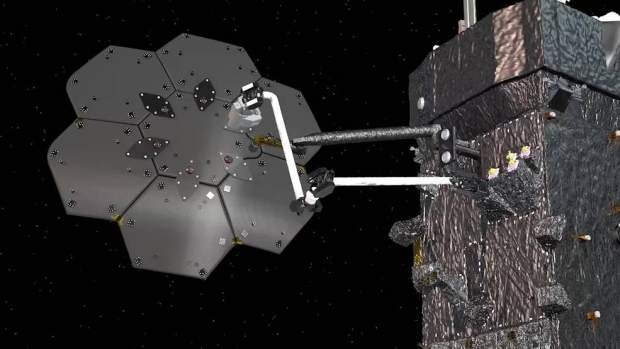
The Space Infrastructure Dexterous Robot (SPIDER) technology demonstration is slated to take place on NASA’s Restore-L spacecraft. The payload will assemble a functional communications antenna and manufacture a spacecraft beam. Image credit: Maxar Technologies.
NASA has awarded a $142 million contract to Maxar Technologies to robotically assemble a communications antenna and manufacture a spacecraft beam in orbit. The technology demonstration is slated to take place on NASA’s Restore-L spacecraft, designed to service and refuel a satellite in low-Earth orbit.
The Restore-L spacecraft will be modified to accommodate a payload called Space Infrastructure Dexterous Robot (SPIDER). The payload includes a lightweight five-metre robotic arm. Previously known as Dragonfly during the ground demonstration phase of the NASA Tipping Point partnership, SPIDER will assemble seven elements to form a functional three-metre communications antenna. The robotically assembled antenna will demonstrate Ka-band transmission with a ground station.
The payload also will manufacture a 10-metre lightweight composite beam using technology developed by Tethers Unlimited. The manufacturing element of the demonstration will verify the capability to construct large spacecraft structures in orbit.
“This technology demonstration will open up a new world of in-space robotic capabilities,” said Jim Reuter, associate administrator of NASA’s Space Technology Mission Directorate.
The demonstration will mature technologies with cross-cutting applications for government and commercial missions, including human exploration of the Moon and Mars and in-space construction of large telescopes.
“In-space assembly and manufacturing will allow for greater mission flexibility, adaptability, and resilience, which will be key to NASA’s Moon to Mars exploration approach,” said Brent Robertson, project manager of Restore-L at NASA’s Goddard Space Flight Centre in Greenbelt, Maryland. The Restore-L project is developing a suite of technologies capable of refuelling and servicing satellites in space. The spacecraft is currently targeted for launch in the mid-2020s.






